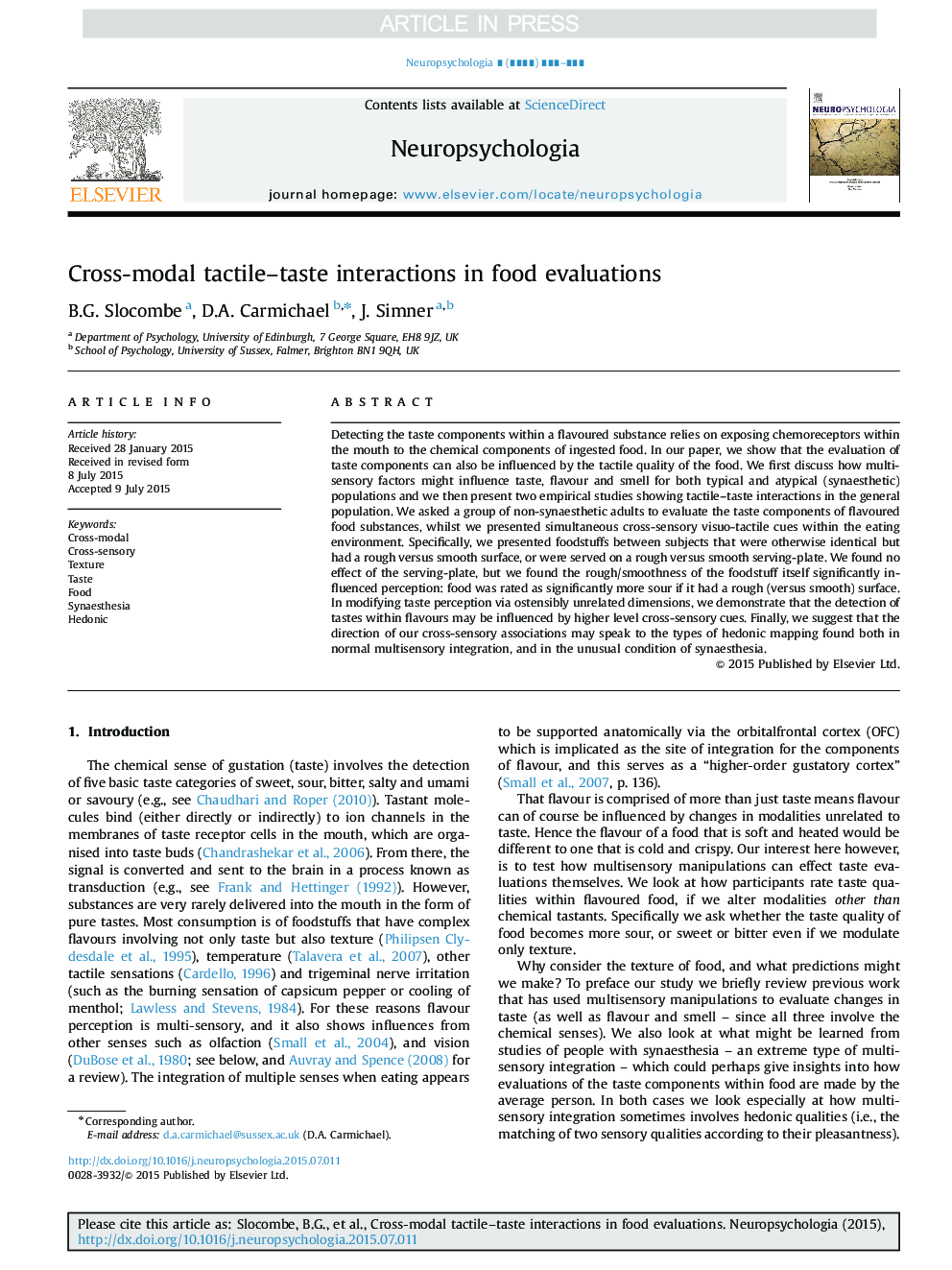| کد مقاله | کد نشریه | سال انتشار | مقاله انگلیسی | نسخه تمام متن |
|---|---|---|---|---|
| 7318818 | 1475566 | 2016 | 7 صفحه PDF | دانلود رایگان |
عنوان انگلیسی مقاله ISI
Cross-modal tactile-taste interactions in food evaluations
ترجمه فارسی عنوان
تعاملات لمسی و طعم متقابل در ارزیابی مواد غذایی
دانلود مقاله + سفارش ترجمه
دانلود مقاله ISI انگلیسی
رایگان برای ایرانیان
کلمات کلیدی
متقابل متقابل حسی، بافت، طعم غذا، سینوشه، هدیونیک،
ترجمه چکیده
تشخیص عناصر طعم دهنده در یک ماده طعم دهنده، متکی به قرار دادن شیمی درمانی درون دهان به مواد شیمیایی مواد خوراکی است. در مقاله ما نشان می دهیم که ارزیابی اجزای طعم نیز می تواند با کیفیت لمسی غذا تحت تاثیر قرار گیرد. ابتدا در مورد چگونگی تاثیر عوامل مختلف چندگانه بر طعم، طعم و بو برای هر دو جمعیت معمول و غیر معمول (سینستیک) بحث خواهیم کرد و سپس دو مطالعه تجربی را نشان می دهیم که تعاملات لمسی و طعم در جمعیت عمومی را نشان می دهد. ما از یک گروه از افراد غیر سیناستیک خواسته شد تا عناصر طعم مواد غذایی طعم دهنده را ارزیابی کنند، در حالی که ما نشانه های بصری متقابل حساسیتی را در محیط غذا ارائه می دادیم. به طور خاص، ما مواد غذایی را بین افراد که در غیر این صورت یکسان بودند، اما در مقایسه با سطح صاف و یا در خدمت بر روی صفحه نمایش خشن در برابر صاف خدمت ارائه شده است. ما هیچ اثری از خدمت را پیدا نکردیم، اما ما متوجه شدیم که مواد خام / نرمی مواد غذایی خود را به طور قابل توجهی تحت تأثیر قرار می دهند: غذا به مقدار قابل توجهی تر تر شده بود، اگر سطح خشن (در برابر صاف) داشته باشد. در اصلاح طرز تفکر از طریق ابعاد ظاهری غیر مرتبط، ما نشان می دهد که تشخیص سلیقه در طعم ممکن است تحت تاثیر قرار با نشانه های سطح بالاتر از حسی. در نهایت، ما پیشنهاد می دهیم که جهت ارتباطات متقابل حسی ما ممکن است به انواع نقشه های هودینی که در هر دو ادغام چند عاملی طبیعی و در شرایط غیر معمول از سینما بیایند صحبت کنند.
موضوعات مرتبط
علوم زیستی و بیوفناوری
علم عصب شناسی
علوم اعصاب رفتاری
چکیده انگلیسی
Detecting the taste components within a flavoured substance relies on exposing chemoreceptors within the mouth to the chemical components of ingested food. In our paper, we show that the evaluation of taste components can also be influenced by the tactile quality of the food. We first discuss how multisensory factors might influence taste, flavour and smell for both typical and atypical (synaesthetic) populations and we then present two empirical studies showing tactile-taste interactions in the general population. We asked a group of non-synaesthetic adults to evaluate the taste components of flavoured food substances, whilst we presented simultaneous cross-sensory visuo-tactile cues within the eating environment. Specifically, we presented foodstuffs between subjects that were otherwise identical but had a rough versus smooth surface, or were served on a rough versus smooth serving-plate. We found no effect of the serving-plate, but we found the rough/smoothness of the foodstuff itself significantly influenced perception: food was rated as significantly more sour if it had a rough (versus smooth) surface. In modifying taste perception via ostensibly unrelated dimensions, we demonstrate that the detection of tastes within flavours may be influenced by higher level cross-sensory cues. Finally, we suggest that the direction of our cross-sensory associations may speak to the types of hedonic mapping found both in normal multisensory integration, and in the unusual condition of synaesthesia.
ناشر
Database: Elsevier - ScienceDirect (ساینس دایرکت)
Journal: Neuropsychologia - Volume 88, 29 July 2016, Pages 58-64
Journal: Neuropsychologia - Volume 88, 29 July 2016, Pages 58-64
نویسندگان
B.G. Slocombe, D.A. Carmichael, J. Simner,
